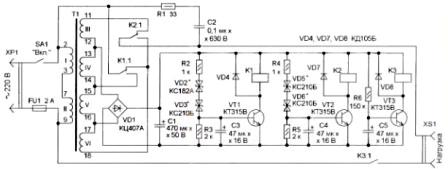Categories: Featured Articles » Practical Electronics
Number of views: 48709
Comments on the article: 0
Step voltage regulator
 A regulator that supports mains voltage within 190 ... 242 V.
A regulator that supports mains voltage within 190 ... 242 V.
Mains voltage regulators
It is known that voltage in domestic power grids often goes beyond tolerance limits. In the days of tube TVs, ferroresonant stabilizers were very common. Modern TVs are operable with changes in input voltage within 110 ... 260 V.
The same can be said about computers, CD players, and generally about all the equipment in which switching power supplies are used. But for equipment that feeds directly from the network, the limits of voltage change are much smaller.
A striking example of this technique is a refrigerator, an electric coffee grinder, a food processor, a soldering iron, and an incandescent lamp. Of course, such accuracy of voltage stabilization as for tube TVs is not necessary for such devices, therefore it is quite possible to use a voltage regulating device in steps. A similar regulator will be described in this article.
Step voltage regulation
Despite the simplicity of the design, the regulator has the following data: when the input mains voltage changes in the range of 150 ... 260 V, the output is maintained within the range of 187 ... 242 V. Many household electrical appliances are operational in this range. In the version in which the scheme in the article is shown, the power of the regulator reaches 275 watts, which is quite enough for normal operation, for example, a refrigerator.
A similar method of stepwise voltage regulation is used in some models of uninterruptible power supplies for computers: when the uninterruptible power supply is working from the network, you can hear how the relay clicks in it. This is just a rough adjustment of the output voltage. In this mode, the uninterruptible transformer is used as an autotransformer. In the event of a power failure, the transformer switches to converter mode and runs on battery power.
It is known that a transformer included in the autotransformer mode can operate with a load of almost five times its power. In this design, a transformer with a power of only 57 watts is used, therefore, if it is necessary to increase the power of the entire controller as a whole, it is enough to replace the transformer with a more powerful one.
Of course, now the industry produces network stabilizers based on LATRA (we will not talk about electronic ones here). In such devices, a micromotor with a reducer, controlled, of course, by an electronic circuit, drives a movable contact.
The reliability of such a device will probably be small. An example of such a device can serve as a voltage regulator Resanta Latvian production. Reviews about it can be read on the Internet.
The scheme of the proposed regulator option is shown in Figure 1.
Figure 1. Voltage Regulator Diagram
Description of the electrical circuit of the controller
The basis of the regulator is a unified step-down transformer T1. It is included in the autotransformer circuit. In addition to the transformer, the circuit contains a rectifier for powering the electronic part of the circuit, two threshold devices and an output voltage switching unit. The latter provides some delay in the appearance of voltage at the output. This is necessary in order for the device to enter the operating mode.
When switching the secondary windings, interference is inevitable, from which the relay contacts are burned. To protect against this phenomenon, a chain consisting of a resistor R1 and a capacitor C2 is used.
The electronic part of the device is powered by an unstabilized rectifier, consisting of a diode bridge VD1 and a smoothing capacitor C1.Capacitors C3 and C4 installed in threshold devices are designed to eliminate short-term changes (emissions) of the rectified voltage. The same voltage is used to control the mains voltage.
On the transistor VT3 and the elements C5 and R6 assembled timer delay delay. The device also contains two threshold devices, the design of which is similar.
The first threshold device is made on transistor VT1, resistors R2, R3, zener diodes VD2, VD3, and capacitor C3. Relay K1 is included in the collector circuit of transistor VT1. To protect the transistor from the self-induction voltage, the relay coil is shunted by the VD4 diode.
The contacts of the relay K1 switch the windings of the transformer T1 when the threshold device is triggered. Capacitor C3 is designed to smooth the ripple of the rectified voltage, as well as eliminate interference. The second threshold device is assembled in the same way. It consists of elements VT2, VD4, VD5, R4, R5, C4, relay K2.
Voltage regulator
The operation of the regulator is convenient to consider in parts. When the device is turned on, a voltage appears on capacitor C1, which starts charging capacitor C5. With a delay of about two seconds, the VT3 transistor opens, the K3 relay turns on, and voltage is applied to the load.
Mains voltage reduced
In the case when mains voltage less than 190 V, no threshold device will work and the contacts of relays K1 and K2 are in that position, as shown in the diagram. In this case, the mains voltage will be applied to the load and plus voltage from the windings III and VI. If the mains voltage at this moment is 150 V, the load will be at least 190 V.
Mains voltage is almost normal
If the mains voltage is in the range 190 ... 220 V, the output voltage of the rectifier is sufficient to open the Zener diodes VD2, VD3, which will lead to the opening of the transistor VT1, so relay K1 will trip. if you follow the scheme, you can see that in this case the windings III and IV are connected.
Mains voltage increased
In the event that the mains voltage exceeds 220 V, the K2 relay will operate, which will connect the V and IV windings with its contacts. These windings are out of phase, so the output voltage will decrease.
Details and design of the voltage regulator
Almost all parts can be mounted on a printed breadboard by wire mounting. In the design, you can use resistors such as MLT or imported. Oxide capacitors are also better imported, now they are probably easier to buy than domestic ones. And their quality is better. The diode bridge can be replaced by discrete diodes, for example 1N4007. Transistors are suitable for any low-power with a collector-emitter voltage of at least 30 V and a current sufficient to trigger the relay. In addition to those indicated on the diagram, KT645, KT503, KT972 with any letter index are suitable.
Instead of the two-zener diodes indicated on the diagram, the usual D810 ... D814 can be used. Before installation, they should be selected according to the voltage in accordance with the diagrams.
It is better to use imported relays (Tianbo, Trl, Trk and the like, they are also now easier and cheaper to buy) with a 24 V coil. Relay contacts must be rated for a current of at least 1.5 A. Many of these relays, at very small dimensions, have contacts designed for a current of 10 ... 16 A.
A unified TPP270 - 127/220 - 50 is used as a transformer. The rated power of such a transformer is 57 watts.
Device setup
For adjustment, the regulator is connected to the LATR output. In order to take into account the response of the transformer to the load, the latter is connected to the output of the device. By changing the voltage at the input of the regulator, it is necessary to configure threshold devices. This should be done with a selection of zener diodes with different stabilization voltages. For more precise tuning in series with zener diodes, you can turn on silicon or germanium diodes. It should be remembered that the direct voltage of silicon diodes is about 0.7 V, and that of germanium 0.4 V.
Boris Aladyshkin
See also at bgv.electricianexp.com
:

